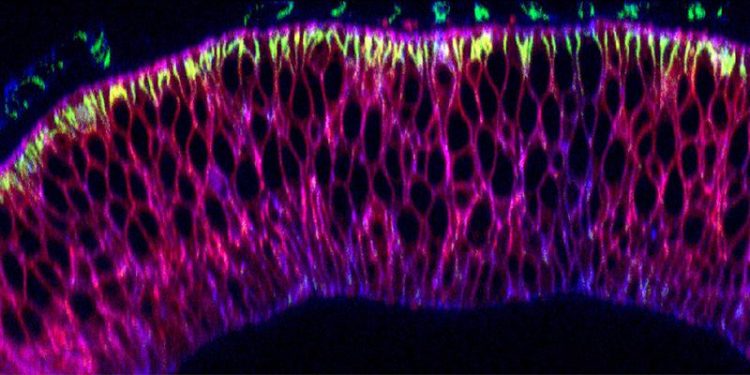Relocation of Proteins with a New Nanobody Tool

Nanobodies (pink) in the wing precursor of a fruit fly larva. University of Basel, Biozentrum
The research group of Markus Affolter is investigating the growth of the wings of the fruit fly Drosophila to understand which processes control organ development and growth. Proteins that control such growth processes are the focus of their investigations.
In this context, not only the composition of the proteins is important, but also their position which can influence protein function. The new nanobody tool of the Affolter research team allows the relocation of proteins and thus to study their function in a position-dependent manner.
Novel tool for all GFP-bound proteins
A repositioning of the proteins of interest requires a labeling with the green fluorescent protein (GFP). Subsequently, so-called anti-GFP nanobodies, small antibody fragments derived from camels, are then used to bind and to move the GFP-tagged proteins to a new site in the living organism. The nanobody itself is linked to a signal protein that defines the destination of the target protein.
Thus, the nanobody forces the GFP-tagged protein into a new position. “Even if we do not know exactly the composition and structure of a protein, we can label it with GFP and control the destination site by using nanobodies,” says Stefan Harmansa, one of the two first authors.
Artificial relocation with nanobodies
The researchers were able to transfer proteins to a new site, internal or external to the cell. “By transporting proteins to new locations, we can observe whether their function changes or not and whether development is affected,” says Ilaria Alborelli, also one of the first authors of the study.
So far, scientists have been restricted in relocating proteins. The new nanobody tool, however, makes it possible to easily and efficiently change the position of all GFP-tagged proteins and thus explore their functions. The Affolter group has already been successful in investigating the growth of Drosophila wings using this nanobody tool. By interfering with the signaling molecule Dpp in a position-dependent manner, the scientists have been able to show more precisely its influence on wing growth.
In the future, the new nanobody tool can be used for a wide variety of studies on organ growth and in various other areas of developmental biology. With this concept, the growth and the development of different cells and organs can be investigated in more detail.
The Affolter team also faces many new challenges. “We as developmental biologists are still confronted with urgent questions such as how an organism knows when it has to stop its growth. To put it succinctly, how does it work that arms or legs stop growing when they reach their correct length?”, says Stefan Harmansa. In the future, the novel tool may contribute to a better understanding of how organ growth is regulated.
Original source
Stefan Harmansa, Ilaria Alborelli, Dimitri Bieli, Emmanuel Caussinus and Markus Affolter
A nanobody-based toolset to investigate the role of protein localization and dispersal in Drosophila
eLife (2017), doi: 10.7554/eLife.22549
Further information
Prof. Dr. Markus Affolter, University of Basel, Biozentrum, tel. +41 61 207 20 72, email: markus.affolter@unibas.ch
Heike Sacher, University of Basel, Biozentrum, Communications, tel. +41 61 207 14 49, email: heike.sacher@unibas.ch
Media Contact
More Information:
http://www.unibas.chAll latest news from the category: Life Sciences and Chemistry
Articles and reports from the Life Sciences and chemistry area deal with applied and basic research into modern biology, chemistry and human medicine.
Valuable information can be found on a range of life sciences fields including bacteriology, biochemistry, bionics, bioinformatics, biophysics, biotechnology, genetics, geobotany, human biology, marine biology, microbiology, molecular biology, cellular biology, zoology, bioinorganic chemistry, microchemistry and environmental chemistry.
Newest articles

Properties of new materials for microchips
… can now be measured well. Reseachers of Delft University of Technology demonstrated measuring performance properties of ultrathin silicon membranes. Making ever smaller and more powerful chips requires new ultrathin…

Floating solar’s potential
… to support sustainable development by addressing climate, water, and energy goals holistically. A new study published this week in Nature Energy raises the potential for floating solar photovoltaics (FPV)…

Skyrmions move at record speeds
… a step towards the computing of the future. An international research team led by scientists from the CNRS1 has discovered that the magnetic nanobubbles2 known as skyrmions can be…





















